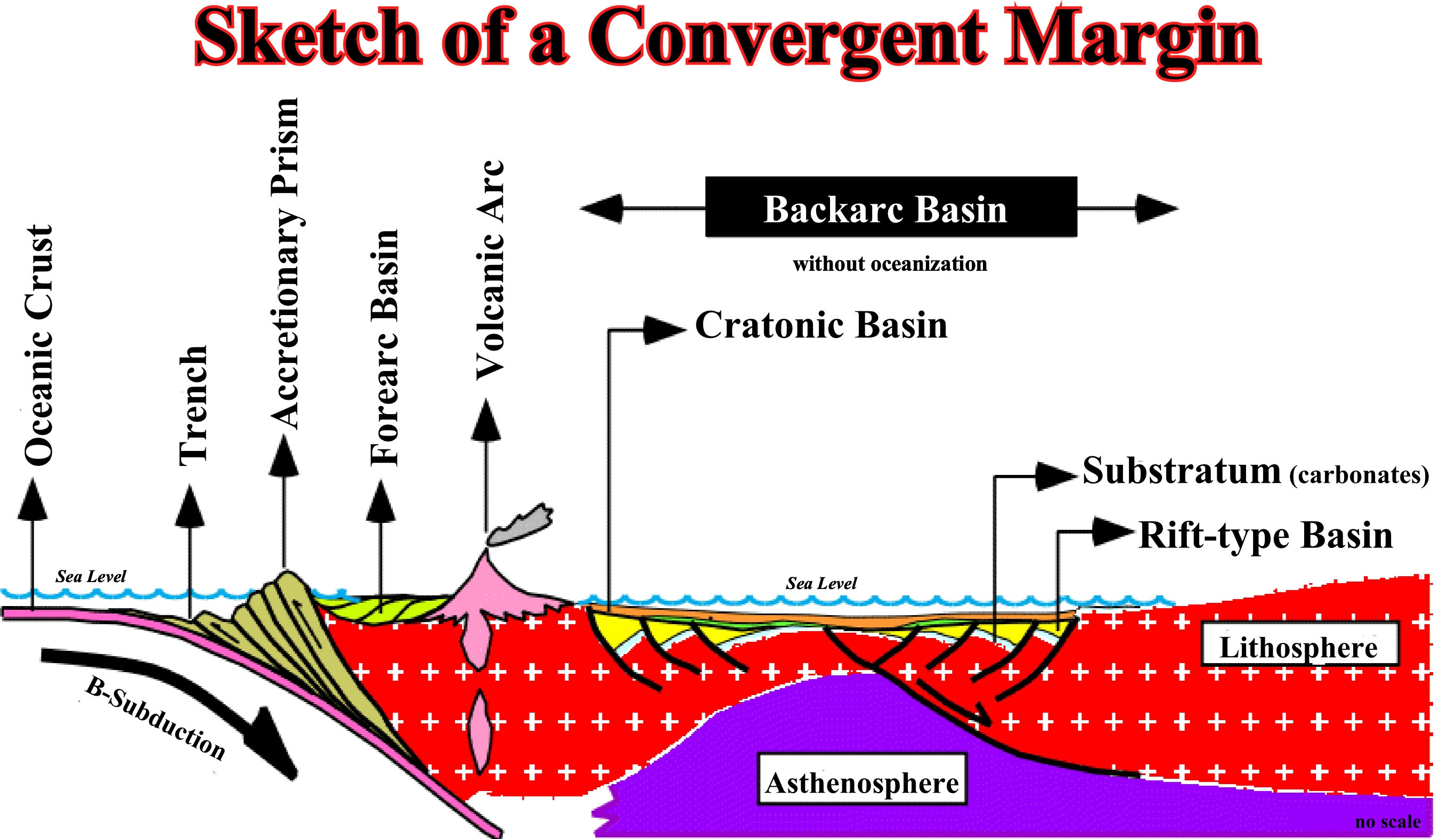

Convergent Margin
Convergent margins are associated with subduction zones. In these zones, a descending or descending lithospheric plate (oceanic or continental) plunges under another lithospheric plate (overriding plate). In the sketch below, the convergent margin corresponds to the subduction of an oceanic lithospheric plate, which can be defined by a divergent boundary, at the level of a mid-oceanic ridge (no visible in the sketch), and by a convergent boundary, at the level of the subduction zone. There are two families of convergent margins : (i) Subduction margins and (ii) Collisions margins.
(i) Subduction Margins
One or both lithospheric plates are oceanic. The plunging plate is, always, oceanic (B-Type or Benioff subduction). In subduction margins, geoscientists differentiate: (a) Marianna-Type, when both lithospheric plates are oceanic (often, it has an oceanic trench and an important volcanic arc) and (b) Andine-Type, when the overriding plate is continental (characterized by an oceanic trench and a continental magmatic arc).
(ii) Collision Margins
When the plunging lithospheric plate is continental (A-type or Ampferer subduction). The overriding plate can be continental or oceanic. Two types can be distinguished : (a) Alpine/Hymalian-Type, when both lithospheric plates are continental (strong shortening and formation of a folded belt with thrusting) and (b) Taiwan-Type, when the overriding plate is oceanic (the plunging plate being continental offers a lot of resistance to penetration, which creates an important vertical deformation).
NB: (1) The term collision, particularly when refereed to the continental crust is, for a lot of geoscientists, inappropriate ; (2) J. Goguel (1964) point out this term evokes, in common life, a transformation of kinetic energy into transformation energy ; (3) The kinetic energy has no role in the deformation of the Earth's crust ; 4) The Plate Tectonics paradigm recognizes the rigidity of the oceanic crust ; (5) It predicts the areas where the oceanic crust comes from (mid-oceanic ridges) and where it disappears (subduction zones) ; (6) In the framework of the Plate Tectonics, it is always inconsistent to talk about collision of continental blocks following the closure of a sea or an ocean like Wegener thought.

On this sketch of a convergent margin, continentward, geoscientists recognize :
(i) The oceanic crust of the plunging lithospheric plate, which is, mainly, under the ocean, with an average density of about 3 g/cm3 and formed by rocks, generally, younger than the rocks forming the continental crust (there is no oceanic crust older than 200 Ma) ;
(ii) The oceanic or abyssal trench, which is a depression of the ocean floor, in general, arched, narrow and much deeper than the adjacent ocean, induced and associated to the B-type subduction zone ;
(iii) The accretionary wedge (accretionary prism) lying, partially, on the oceanic trench over the B-type subduction zone, in the seaward border of the overriding plate, is composed, mainly, by marine sediments scraped off from the subducting oceanic crust (erosional debris from the volcanic island arcs formed on the overriding plates can, also, be constituents of the material forming the accretionary wedge) ;
(iv) The forearc basin, which is a perisutural basin, i.e., developed at the periphery of the megasuture (external to the volcanic arch), in association with a B-type (Benioff) ;
(v) the volcanic arc ;
(vi) The backarc basin (without oceanization), which corresponds to the stacking of different sedimentary basins above a basement (often a Paleozoic or Mesozoic fold belt) covered by a pre-rifting sedimentary infrastructure (carbonate platform). Rift-type basins emphasizing a differential subsidence (rifting phase) and a cratonic basin characterized by a thermal subsidence.
Send E-mails to carlos.cramez@bluewin.ch with comments and suggestions to improve this atlas.
Copyright © 2001 CCramez
Last update:
2022